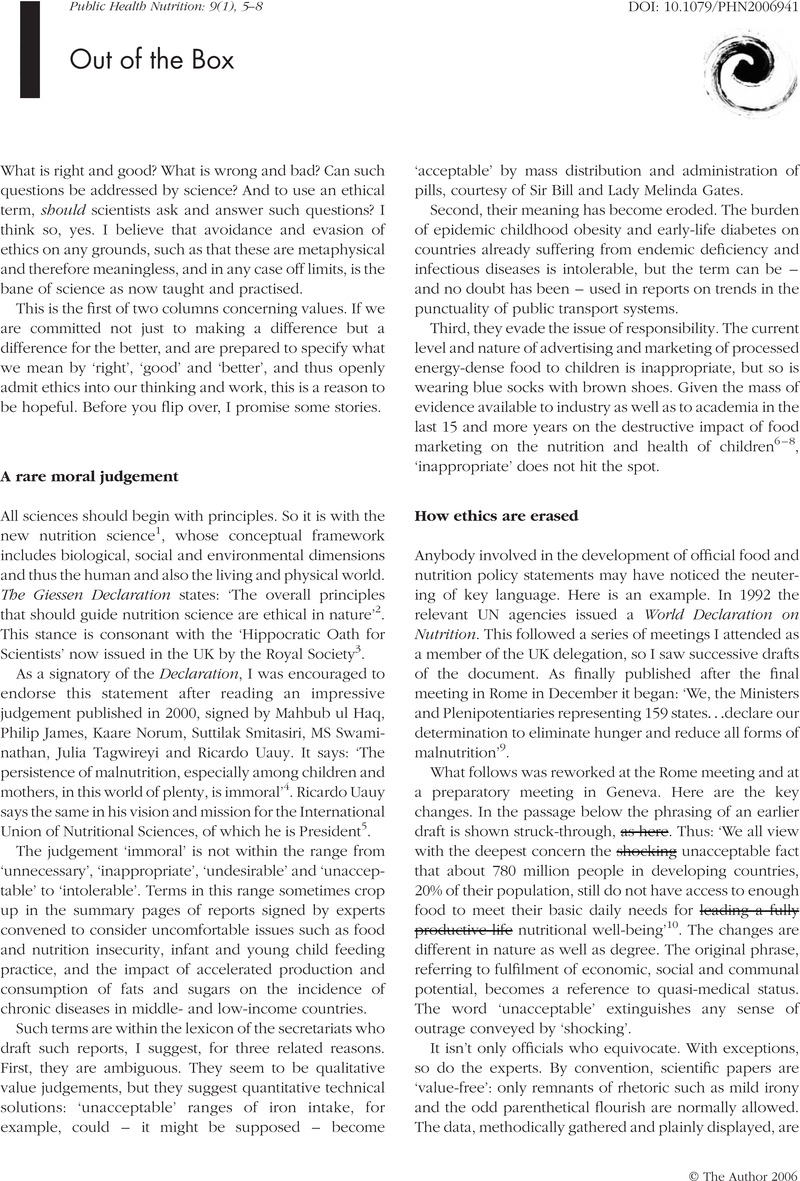No CrossRef data available.
Article contents
Out of the Box
Published online by Cambridge University Press: 02 January 2007
Abstract
An abstract is not available for this content so a preview has been provided. As you have access to this content, a full PDF is available via the ‘Save PDF’ action button.

- Type
- Out of the Box
- Information
- Copyright
- Copyright © The Author 2006
References
1Leitzmann, C, Cannon, G, eds. The New Nutrition Science project [special issue]. Public Health Nutrition 2005; 8(6A): 667–804.Google ScholarPubMed
3Royal Society. Rigour, Respect and Responsibility: A Universal Ethical Code for Scientists. London: Royal Society, 2006. Also available at http://www.royalsoc.ac.ukGoogle Scholar
4Commission on the Nutrition Challenges of the 21st Century. Ending Malnutrition by 2020: An Agenda for Change in the Millennium. Final report to the ACC/SCN. Food and Nutrition Bulletin 2000; 21(3): 3–88.Google Scholar
5Uauy, R. Defining and addressing the nutritional needs of populations. Public Health Nutrition 2005; 8(6A): 773–80.CrossRefGoogle ScholarPubMed
6National Food Alliance (NFA) (now Sustain). Children: Advertisers' Dream, Nutrition Nightmare? The Case for More Responsibility in Food Advertising. London: NFA, 1993. Also available at http://www.sustainweb.orgGoogle Scholar
7Hawkes, C. Marketing Food to Children: The Global Regulatory Framework. Geneva: World Health Organization, 2004. Also available at http://www.who.intGoogle Scholar
8Institute of Medicine. Food Marketing to Children and Youth: Threat or Opportunity? Washington, DC: National Academies Press, 2006. Also available at http://www.nap.eduGoogle Scholar
10FAO/WHO. World Declaration and Plan of Action for Nutrition. Draft submitted to the Preparatory Committee, Geneva, August 1992. Rome: FAO/WHO, 1992.Google Scholar
11Medawar, P. The limits of science [Chapter 4]. The Limits of Science. Oxford: University Press, 1985.Google Scholar
12Cannon, G, Leitzmann, C. The new nutrition science project. Public Health Nutrition 2005; 8(6A): 673–94.CrossRefGoogle ScholarPubMed
13Leitzmann, C, Cannon, G. Dimensions, domains and principles of the new nutrition science. Public Health Nutrition 2005; 8(6A): 787–94.CrossRefGoogle ScholarPubMed
14WHO. Global and regional food consumption patterns and trends [Chapter 3]. Diet, Nutrition and the Prevention of Chronic Diseases. Report of a Joint WHO/FAO Expert Consultation. WHO Technical Report Series No. 916. Geneva: WHO, 2003.Google Scholar
15Poincaré, J. The Foundations of Science. Washington, DC: University Press of America, 1982 [originally published in three volumes in French, 1902–1908].Google Scholar
16Popper, K. Nature and convention [Chapter 5]. The Open Society and its Enemies. London: Routledge and Kegan Paul, 1945.Google Scholar
17Popper, K. The path of science [Chapter X, section 85]. The Logic of Scientific Discovery. London: Hutchinson, 1959 [originally published in German, 1934].Google Scholar
18Hart, H. Laws and morals [Chapter IX] The Concept of Law. Oxford: University Press, 1961.Google Scholar
19World Cancer Research Fund (WCRF)/American Institute for Cancer Research (AICR). Scientific evidence and judgement [Chapter 3]. Food, Nutrition and the Prevention of Cancer: A Global Perspective. Washington, DC: WCRF/AICR, 1997.Google Scholar
20WHO. Population nutrient intake goals for preventing diet-related chronic diseases [Chapter 5]. Diet, Nutrition and the Prevention of Chronic Diseases. Report of a Joint WHO/FAO Expert Consultation. WHO Technical Report Series No. 916. Geneva: WHO, 2003.Google Scholar
21Niven, W, ed. The Scientific Papers of James Clerk Maxwell. Cambridge: University Press, 1890.Google Scholar
22Dawkins, R. Snake oil and holy water. Forbes Magazine, 10 04 1999. Also available at http://www.forbes.com/asap/1999/0114/235Google Scholar
23Mooney, C. ‘Creation science’ and Reagan's ‘dream’ [Chapter 4]. The Republican War on Science. New York: Basic Books, 2005.Google Scholar
24Mount, H. Keep the divine out of biology lessons, federal judge rules. Daily Telegraph, 21 12 2005.Google Scholar
25US Supreme Court. Edwards v Aguillard. Decision. Amicus Curiae brief of 72 Nobel laureates, 17 state academies of science, and 7 other scientific organizations in support of appellees, 18 08 1986. Available at http://www.talkorigins.org/faqs/edwards-aguillard/amicus1.htmlGoogle Scholar
26Gould, SJ. Walcott's vision and the nature of history [Chapter IV]. Wonderful Life. The Burgess Shale and the Nature of History. London: Penguin, 1991.Google Scholar
27John, Paul II. Theories of Evolution. Address to the Pontifical Academy of Sciences, 22 October 1997. Rome: Vatican, 1999. Also available at http://www.firstthings.com.ftissues/ft9703/articles/johnpaul.htmlGoogle Scholar
29Gould, SJ. Rocks of Ages. Science and Religion in the Fullness of Life. New York: Ballantine, 1999.Google Scholar
30UNESCO. Universal Declaration on Bioethics and Human Rights. Paris: UNESCO, 2005. Also available at http://www.unesco.org/shs/bioethicsGoogle Scholar




